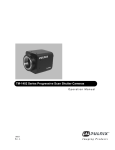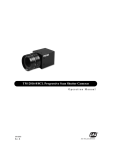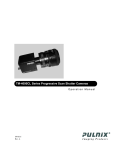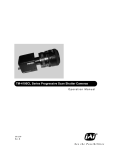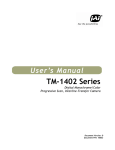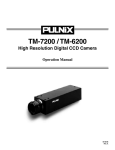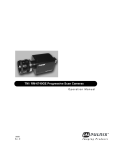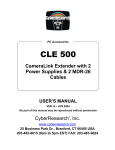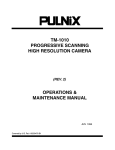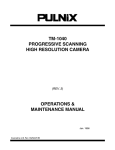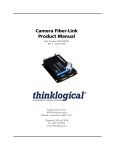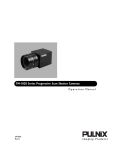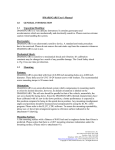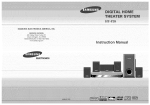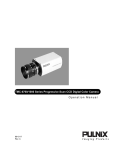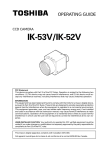Download JAI TM-6760 User's Manual
Transcript
TM-6760 Series Progressive Scan Shutter Cameras Operation Manual 69-1141 Rev. B Page iii Notice The material contained in this manual consists of information that is proprietary to JAI, Inc., and may only be used by the purchasers of the product. JAI, Inc. makes no warranty for the use of its product and assumes no responsibility for any errors which may appear or for damages resulting from the use of the information contained herein. JAI, Inc. reserves the right to make changes without notice. Microsoft, Windows XP, Windows 98, Windows 95, Windows NT, and Windows Explorer are either registered trademarks or trademarks of Microsoft Corporation in the United States and/or other countries. Warranty Contact your factory representative for warranty information. Certifications CE Compliance The TM-6760 series of cameras has been certified to conform to the requirements of Council Directive 89/336/EC for electromagnetic compatibility and to comply with the following European Standards: Immunity: Emissions: EN50082-2/1997 CISPR22: 1997/EN55011: 1998 Class B All JAI Inc. products bearing the CE mark have been declared to be in conformance with the applicable EEC Council Directives. However, certain factory-installed options or customer-requested modifications may compromise electromagnetic compatibility and affect CE compliance. Please note that the use of interconnect cables that are not properly grounded and shielded may affect CE compliance. Contact JAI Inc. Applications Engineering Department for further information regarding CE compliance. FCC UL ® ST I SS O CIA TI O N RM FILE # A3942 REG MEMBER A FI TED IM MA O NG GI A AU T This equipment has been tested and found to comply with the limits for a Class A digital device, pursuant to Part 15 of the FCC Rules. These limits are designed to provide reasonable protection against harmful interference when the equipment is operated in a commercial environment. This equipment generates, uses and can radiate radio frequency energy and, if not installed and used in accordance with the instruction manual, may cause harmful interference to radio communications. Operation of this equipment in a residential area may cause harmful interference, in which case the user will be required to correct the interference at his own expense. ERED JAI, INC. ISO-9001 Page iv WARNING Changes or modifications to this unit not expressly approved by the party responsible for FCC compliance could void the user’s authority to operate the equipment. TM-6760 Series Operation Manual JAI, Inc. 625 River Oaks Parkway San Jose, CA 95134 Tel:(408) 383-0300 Tel:(800) 445-5444 Fax:(408) 383-0301 E-mail: [email protected] www.jai.com Page v Table of Contents Table of Contents . . . . . . . . . . . . . . . . . . . . . . . . . . . . . . . . . . . . . v List of Figures. . . . . . . . . . . . . . . . . . . . . . . . . . . . . . . . . . . . . . . vii List of Tables. . . . . . . . . . . . . . . . . . . . . . . . . . . . . . . . . . . . . . . . .ix 1 Introduction . . . . . . . . . . . . . . . . . . . . . . . . . . . . . . . . . . . . 1 1.1 1.2 1.3 1.4 Product Description . . . . . . . . . . . . . . . . . . . . . . . . . . . . . . . . . . 1 Features. . . . . . . . . . . . . . . . . . . . . . . . . . . . . . . . . . . . . . . . . . . . 2 Functional Options . . . . . . . . . . . . . . . . . . . . . . . . . . . . . . . . . . . 3 System Configuration. . . . . . . . . . . . . . . . . . . . . . . . . . . . . . . . . 4 2 Installation . . . . . . . . . . . . . . . . . . . . . . . . . . . . . . . . . . . . . 5 2.1 Getting Started . . . . . . . . . . . . . . . . . . . . . . . . . . . . . . . . . . . . . . 5 2.1.1 Unpacking Instructions . . . . . . . . . . . . . . . . . . . . . . . . . . . . . . . . . . . . . 5 2.1.2 Components List . . . . . . . . . . . . . . . . . . . . . . . . . . . . . . . . . . . . . . . . . . 5 2.1.3 Accessories and Options. . . . . . . . . . . . . . . . . . . . . . . . . . . . . . . . . . . . 5 2.2 Camera Setup . . . . . . . . . . . . . . . . . . . . . . . . . . . . . . . . . . . . . . . 6 2.2.1 2.2.2 2.2.3 2.2.4 2.2.5 2.2.6 2.2.7 2.2.8 2.2.9 Heat Dissipation . . . . . . . . . . . . . . . . . . . . . . . . . . . . . . . . . . . . . . . . . . 6 Connector Pin Configurations . . . . . . . . . . . . . . . . . . . . . . . . . . . . . . . 6 Shutter Speed Control Dial (TM-6760 only) . . . . . . . . . . . . . . . . . . . . 9 RS-232 Communication Cable (TM-6760 only) . . . . . . . . . . . . . . . . . 9 Digital Output Cable (TM-6760 LVDS model only) . . . . . . . . . . . . . 10 Camera Link Cable (TM-6760CL only). . . . . . . . . . . . . . . . . . . . . . . 11 Power Supplies and Power Cable Setup . . . . . . . . . . . . . . . . . . . . . . . 11 Attaching the Analog Video Output . . . . . . . . . . . . . . . . . . . . . . . . . . 12 Attaching the Camera Lens. . . . . . . . . . . . . . . . . . . . . . . . . . . . . . . . . 13 3 Operation . . . . . . . . . . . . . . . . . . . . . . . . . . . . . . . . . . . . . 14 3.1 Camera Rear Panel (TM-6760, LVDS model only) . . . . . . . . . 14 3.1.1 3.1.2 3.1.3 3.1.4 3.1.5 3.1.6 Up/Down Switch . . . . . . . . . . . . . . . . . . . . . . . . . . . . . . . . . . . . . . . . 14 Digital Output Connector . . . . . . . . . . . . . . . . . . . . . . . . . . . . . . . . . . 14 Analog Output Connector. . . . . . . . . . . . . . . . . . . . . . . . . . . . . . . . . . 14 Power, RS-232, and External Sync Connector . . . . . . . . . . . . . . . . . . 14 Shutter Speed Control Switch. . . . . . . . . . . . . . . . . . . . . . . . . . . . . . . 14 Mode Selection Switch . . . . . . . . . . . . . . . . . . . . . . . . . . . . . . . . . . . . 14 3.2 Camera Rear Panel (TM-6760CL) . . . . . . . . . . . . . . . . . . . . . . 16 3.2.1 Digital Output Connector (Camera Link Connector) . . . . . . . . . . . . . 16 3.2.2 Analog Output Connector. . . . . . . . . . . . . . . . . . . . . . . . . . . . . . . . . . 16 3.2.3 Power and External Sync Connector . . . . . . . . . . . . . . . . . . . . . . . . . 16 3.3 3.4 3.5 3.6 Progressive Scanning . . . . . . . . . . . . . . . . . . . . . . . . . . . . . . . . 17 Electronic Shutter . . . . . . . . . . . . . . . . . . . . . . . . . . . . . . . . . . . 17 Integration. . . . . . . . . . . . . . . . . . . . . . . . . . . . . . . . . . . . . . . . . 18 Asynchronous Reset . . . . . . . . . . . . . . . . . . . . . . . . . . . . . . . . . 18 3.6.1 External VINIT With Pulse Width (No-Delay Shutter) . . . . . . . . . . . 18 3.6.2 Internal Shutter Speed Control . . . . . . . . . . . . . . . . . . . . . . . . . . . . . . 19 3.7 Dynamic Range Control . . . . . . . . . . . . . . . . . . . . . . . . . . . . . 20 3.7.1 Programmable Look-Up Table (LUT) and Knee Control . . . . . . . . . 20 Table of Contents Page vi 3.8 Programmable LUT and Knee Control (patent pending). . . . . 21 3.9 Scan Modes . . . . . . . . . . . . . . . . . . . . . . . . . . . . . . . . . . . . . . . 22 3.9.1 Full Progressive Scan . . . . . . . . . . . . . . . . . . . . . . . . . . . . . . . . . . . . . 22 3.9.2 Partial Scan . . . . . . . . . . . . . . . . . . . . . . . . . . . . . . . . . . . . . . . . . . . . . 22 3.9.3 Two-Row Binning . . . . . . . . . . . . . . . . . . . . . . . . . . . . . . . . . . . . . . . 22 3.10 External Sync and Pixel Locking . . . . . . . . . . . . . . . . . . . . . . . 22 3.11 Bayer Color Filter (TMC-6760 and TMC-6760CL) . . . . . . . . 22 3.11.1 Color Filter Array . . . . . . . . . . . . . . . . . . . . . . . . . . . . . . . . . . . . . . . . 23 3.11.2 Bayer Color Filter Array (CFA) . . . . . . . . . . . . . . . . . . . . . . . . . . . . . 23 3.11.3 Starting Pixel Configuration. . . . . . . . . . . . . . . . . . . . . . . . . . . . . . . . 24 3.11.4 Sync and Data. . . . . . . . . . . . . . . . . . . . . . . . . . . . . . . . . . . . . . . . . . . 24 3.11.5 Camera Functions . . . . . . . . . . . . . . . . . . . . . . . . . . . . . . . . . . . . . . . . 25 3.11.6 Interpolation Software . . . . . . . . . . . . . . . . . . . . . . . . . . . . . . . . . . . . 27 3.11.7 Color Interpolation . . . . . . . . . . . . . . . . . . . . . . . . . . . . . . . . . . . . . . . 27 3.12 Camera Timing Charts . . . . . . . . . . . . . . . . . . . . . . . . . . . . . . . 28 3.13 Serial Communication Kit CS-232C (not required for “CL” version). . . . . . . . . . . . . . . . . . . . . . . . . . . . . . . . . . . . . . . . . . . 32 4 Troubleshooting . . . . . . . . . . . . . . . . . . . . . . . . . . . . . . . . 33 4.1 Problems and Solutions . . . . . . . . . . . . . . . . . . . . . . . . . . . . . . 33 4.1.1 Symptom: No Video . . . . . . . . . . . . . . . . . . . . . . . . . . . . . . . . . . . . . . 33 4.1.2 Symptom: Dark Video . . . . . . . . . . . . . . . . . . . . . . . . . . . . . . . . . . . . 33 4.1.3 Symptom: Non-synchronized Video . . . . . . . . . . . . . . . . . . . . . . . . . 33 4.2 Information and Support Resources . . . . . . . . . . . . . . . . . . . . . 34 5 Appendix . . . . . . . . . . . . . . . . . . . . . . . . . . . . . . . . . . . . . 35 5.1 Specifications . . . . . . . . . . . . . . . . . . . . . . . . . . . . . . . . . . . . . . 35 5.1.1 Physical Dimensions . . . . . . . . . . . . . . . . . . . . . . . . . . . . . . . . . . . . . 37 5.1.2 Spectral Response. . . . . . . . . . . . . . . . . . . . . . . . . . . . . . . . . . . . . . . . 38 Table of Contents Page vii List of Figures FIGURE 1. TM-6760 System Configuration .................................................................... 4 FIGURE 2. TM-6760CL System Configuration............................................................... 4 FIGURE 3. 12-Pin Connector on Rear Panel of Camera .................................................. 6 FIGURE 4. 31-Pin Digital Connector on Rear Panel of Camera (TM-6760 only)........... 7 FIGURE 5. Serial Communication Cable RS-232B-12.................................................... 9 FIGURE 6. Pinout Configuration for Digital Output Cable ........................................... 10 FIGURE 7. 12P-02S Interface Cable (optional) ............................................................. 12 FIGURE 8. Pulse Width Async Shutter Timing.............................................................. 19 FIGURE 9. Bayer Color Filter Array.............................................................................. 23 FIGURE 10. Starting Pixel Configuration ........................................................................ 24 FIGURE 11. Sync and Data .............................................................................................. 25 FIGURE 12. TM-6760 Series Camera Rear Panel ........................................................... 26 FIGURE 13. Physical Dimensions (TM-6760, TMC-6760)............................................. 37 FIGURE 14. Physical Dimensions (TM-6760CL, TMC-6760CL)................................... 37 FIGURE 15. Spectral Response ........................................................................................ 38 List of Figures Page viii List of Figures Page ix List of Tables TABLE 1. 12-Pin Connector (TM-6760) ........................................................................ 6 TABLE 2. 12-Pin Connector (TM-6760CL) ................................................................... 6 TABLE 3. 31-Pin Connector (MP211-031-113-4300) .................................................... 7 TABLE 4. Connector Pinout Configurations (10226-6212 VC)..................................... 8 TABLE 5. Shutter Speed Control Dial ............................................................................ 9 TABLE 6. Mode Selection Switch ................................................................................ 15 TABLE 7. Basic Mode Selections (For Non-CL Versions) .......................................... 26 TABLE 8. Framegrabber Interpolation Software List................................................... 27 TABLE 9. TM-6760 Series Product Specifications Table ............................................ 35 List of Tables Page x List of Tables May 31, 2007 TM-6760 Series Progressive Scan Shutter Cameras Operation Manual 1 Introduction 1.1 Product Description The JAI, Inc. TM-6760 series are VGA format, high-speed monochrome progressive scan CCD cameras.* The progressive interline-type CCD permits full vertical and horizontal resolution of very high speed shutter images and applications. The electronic shutter, which has speeds to 1/32,000 sec., can be reset asynchronously by external pulse control. Three frame rates are available: 30, 60, and 120 fps. On-chip micro lenses provide increased sensitivity. The TM-6760 has a full dynamic range control function, which can be set at externally selectable lookup-table (LUT) knee slopes to convert 10-bit input to 8-bit output, thereby optimizing the CCD’s full dynamic range in the normal output signal range. The camera has an 8-bit, RS-644 digital signal output for interfacing with external image-processing systems. All the key functions are externally controlled via RS-232C. The TM-6760CL model has a Camera Link output and its key functions are externally controlled via differential serial communication of Camera Link. Applications for the TM-6760 include machine vision, medical imaging, intelligent transportation systems, high-definition graphics, on-line inspection, gauging, character reading, archiving, and highsecurity surveillance. *. Unless specifically mentioned, all information in this manual is relevant to all cameras in the TM6760 series, including the RM-6760, RMC-6760, RM-6760CL, RMC-6760CL, TM-6760, TMC6760, TM-6760CL, and TMC-6760CL. TM-6760 Series Progressive Scan Shutter Cameras Page 2 TM-6760 Series Progressive Scan Shutter Cameras 1.2 Features • Miniaturized and lightweight The printed circuit boards in the TM-6760 have been arranged with a new design philosophy in mind. This creates modular electronics for the camera, giving it flexibility. In addition, the use of miniature solid-state components results in a compact, lightweight camera that is 44mm x 44mm x 64mm in dimensions, and weighs only 138 grams. • Imager The TM-6760 uses a progressive scan interline transfer CCD that has the following features: - Resolution of 648 x 484 active pixels for excellent image quality. - 9.0 x 9.0 µm square pixels for precise dimensional measurement. - High-speed electronic shutter capability for high dynamic resolution of moving objects and electronic iris control that eliminates the need for a mechanical shutter. - Progressive scan CCD eliminates interlace deterioration of image and increases ease of computer interface. - High sensitivity and low noise at fast scanning. The CCD has a clock rate faster than 25 MHz pixel and has an excellent S/N ratio that is greater than 48dB. - The CCD for the TM-6760 has built-in microlenses. • Electronic shutter The TM-6760 has a substrate drain-type shutter mechanism which provides superb pictures at various speeds without smearing. A built-in manual shutter speed control selects the electronic shutter rate of 1/125, (non-async mode only) 1/250, 1/500, 1/1,000, 1/2,000, 1/4,000, 1/8,000, 1/16,000, or 1/32,000 second. With VINIT high (5V), the CCD keeps discharging. With a negative pulse to VINIT, the camera resets and purges the charge momentarily. Then it starts integrating for the period of shutter control set by either an external pulse width or internal shutter control. Progressive scanning permits a full 484 lines of vertical resolution, as compared to a conventional CCD camera which captures only half the vertical lines per shutter. • Asynchronous reset The TM-6760’s asynchronous reset is flexible and accepts external horizontal drive (HD) for phase locking. When the VINIT pulse is applied, it resets the camera's scanning and purging of the CCD. There are two modes to control the asynchronous reset and shutter speed: - External VINIT with pulse width. The duration between pulse edges controls the shutter speed externally. - Internal shutter control mode. The speed control varies from 1/250 to 1/32,000 sec. The video signal starts with internal V reset timing related to shutter speed. Introduction Page 3 TM-6760 Series Progressive Scan Shutter Cameras • Output The TM-6760 has an 8-bit RS-644 (LVDS) digital output for interfacing with external imageprocessing systems. The TM-6760 camera is also available with RS-422 digital output as an option (OP-93). The TM-6760CL has a Camera Link output. The analog output is 1.0 Vp-p composite video (75 ohms). • Asynchronous image capturing The TM-6760 captures async reset images and provides single-shot video output with single FDV. This makes it simpler for an ordinary framegrabber to capture the async reset images. • Integration The TM-6760 is capable of capturing high-resolution integration images. Its CCD imager can be exposed for longer than the normal scan timing of 1/60 sec. This integration feature provides extra sensitivity for applications in dark environments. The progressive scan imager permits a full frame of resolution in non-interlace format. Integration is achieved by controlling the #11 pin of the 12pin connector to low (GND) or pulse width control VINIT to pin #6 of the 12-pin connector up to 1 second. 1.3 Functional Options • Differential input, VINIT (OP89-3). • Differential input, VD (OP89-4). • RS-422 (digital) output for the TM-6760 (93). • 10-bit output (OP-93) Introduction Page 4 TM-6760 Series Progressive Scan Shutter Cameras 1.4 System Configuration FIGURE 1. TM-6760 System Configuration Figure 1 below presents a typical system configuration for the TM-6760 camera. UP 3 45 6 23 CDE AB F0 1 2 8 67 9 01 45 78 9 SHUTTER MODE 30DG-02 DOWN DIGITAL 2 3 8 10 11 4 RS-232B-12 cable in CS-232E kit 1 9 7 12 5 6 VIDEO POWER BNC cable 12-pin connectors Analog frame grabber Computer with frame-grabber board PD-12 (series) power supply OR Power and Ext. Sync FIGURE 2. 12P-02S TM-6760CL System Configuration Figure 2 below presents a typical system configuration for the TM-6760CL camera. 26CL-02-26 CAMERA LINK 1 Power and Ext. Sync 12P-02S 2 3 9 8 10 11 4 7 12 5 POWER 6 VIDEO or PD-12U (series) power supply Analog frame grabber* Introduction Computer with Camera Link™ frame grabber Page 5 TM-6760 Series Progressive Scan Shutter Cameras 2 Installation The following instructions are provided to help you to set up your camera quickly and easily. We suggest that you read through these instructions before you unpack and set up your camera system. 2.1 Getting Started 2.1.1 Unpacking Instructions We recommend that you save the original packing cartons for the cameras and accessories in case you need to return or exchange an item. We also recommend that you bench-test any equipment being sent to another location for field installation to assure that everything is fully operational as a system. 2.1.2 Components List Please begin by checking your order against the Components List shown below to assure that you have received everything as ordered, and that nothing has been overlooked in the packing materials. If any item is missing, please contact your JAI, Inc. representative immediately. Data sheets are available for viewing and download online at www.jai.com. • TM-6760 camera • TM-6760 operation manual (if ordered) • Camera-control software manual (CL version only) • Camera-control software (CL version only) 2.1.3 Accessories and Options Following is a list of additional accessories and options that may be required for your application. Please check with your JAI, Inc. representative before you install your camera to determine what you might need. • Digital output cable (not required for “CL” version) - 30DG-02 (for standard model only) - 26CL-02-26 (for Camera Link model only) • Serial Communication Kit CS-232E (not required for “CL” version) Note: For CL models, the control software is included and serial communication is through the Camera Link cable. No additional accessories are required. • PD-12UUP series power supply • 12P-02S power cable Installation Page 6 TM-6760 Series Progressive Scan Shutter Cameras 2.2 Camera Setup 2.2.1 Heat Dissipation The TM-6760 camera is a compact 648K x 484K camera. Since all the electronics have been packed in a compact package, the outer case of the camera gets hot due to heat dissipation. JAI, Inc. recommends the following procedure for optimal performance of the camera: 1. Mount the camera on a large heat sink (camera bracket) made out of conductive material like aluminum. 2. Make sure the flow of heat from the camera case to the bracket is not blocked by a non-conducting material like plastic. 3. Make sure the camera has enough open space around it to facilitate the free flow of air. 4. If possible, use a cooling fan to set up a positive air flow around the camera. 2.2.2 Connector Pin Configurations 2.2.2 (a) FIGURE 3. 12-Pin Connector (TM-6760) 12-Pin Connector on Rear Panel of Camera The TM-6760 has a 12-pin Hirose connector for power input, serial communication, and signal integration. Pin #1 is Ground and Pin #2 is +12V DC. Other pins handle a number of input and output functions, as shown in Table 1 below. TABLE 1. 3 9 11 4 8 10 7 12 5 6 12-Pin Connector (TM-6760) Pin 2.2.2 (b) 1 2 Description Pin Description 1 GND (power) 7 VD In 2 +12V DC 8 Reserved 3 GND (analog) 9 HD In 4 Video Out 10 RXD (RS-232) 5 GND (digital) 11 Integration Control/ ROI 6 VINIT In 12 TXD (RS-232) 12-Pin Connector (TM-6760CL) The TM-6760CL has a 12-pin Hirose connector for power input and signal integration. Pin #1 is Ground and pin #2 is +12V DC. The pinout table is shown below. For the TM-6760CL, serial communication camera control is done via the MDR26 Camera Link connector on the rear panel of the camera. TABLE 2. 12-Pin Connector (TM-6760CL) Pin Installation Description Pin Description 1 GND (power) 7 VD in 2 +12V DC 8 Reserved Page 7 TM-6760 Series Progressive Scan Shutter Cameras TABLE 2. 12-Pin Connector (TM-6760CL) (Continued) Pin 2.2.2 (c) Description Pin Description 3 GND (analog) 9 HD in 4 Video out 10 Reserved 5 GND (digital) 11 Reserved 6 Reserved 12 Reserved Digital Output Connector (TM-6760 only) The TM-6760 has a 31-pin AirBorn connector (MP211-031-113-4300) on the rear panel to output 8-bit, RS-644 video data. The connector pin-out is shown in Figure 4 below. FIGURE 4. 31-Pin Digital Connector on Rear Panel of Camera (TM-6760 only) 1 16 17 31 Note: CLK: data clock, LDV: Line Data Valid, FDV: Frame Data Valid, INTEG: Integration control, EXT CLK: external pixel clock, []: Differential input option. TABLE 3. 31-Pin Connector (MP211-031-113-4300) Pin # Description I/O Pin # Description I/O 1 CLK+ Out 17 CLK- Out 2 LDV+ Out 18 LDV- Out 3 FDV+ Out 19 FDV- Out 4 GND 20 VINIT (TTL) [Integ (TTL)] In In 5 EXT HD (TTL) [EXT CLK+] In 21 EXT VD (TTL) [EXT CLK-] In 6 INTEG (TTL) [HD+] In In 22 N/C [HD-] N/C [VINIT+/ (VD+)] In 8 D0+ Out 9 D1+ 10 7 23 In GND [VINIT-/(VD)] In 24 D0- Out Out 25 D1- Out D2+ Out 26 D2- Out 11 D3+ Out 27 D3- Out 12 D4+ Out 28 D4- Out 13 D5+ Out 29 D5- Out Installation Page 8 TM-6760 Series Progressive Scan Shutter Cameras 31-Pin Connector (MP211-031-113-4300) (Continued) TABLE 3. 2.2.2 (d) Pin # Description I/O Pin # Description I/O 14 D6+ Out 30 D6- Out 15 D7+ Out 31 D7- Out 16 GND Camera Link Connector The TM-6760CL has a 26-pin MDR26 connector (3M part number 10226-6212VC) on the rear panel to output Camera Link data. The connector pin-out is shown in Table 4 below. 13 1 26 TABLE 4. 14 Connector Pinout Configurations (10226-6212 VC)a Camera Link Connector MDR 26-pin Connector 10226-6212VC Pin # Description 1 GND 2 Tx OUT 0- 3 I/O Pin # Description I/O 14 GND (Shield) Out 15 Tx OUT 0+ Out Tx OUT 1- Out 16 Tx OUT 1+ Out 4 Tx OUT 2- Out 17 Tx OUT 2+ Out 5 Tx CLK OUT - Out 18 Tx CLK OUT+ Out 6 Tx OUT 3- Out 19 Tx OUT 3+ Out 7 SerTC+ In 20 SerTC- In 8 SerTFG- Out 21 SerTFG+ Out 9 VINIT- (CC1-) In 22 VINIT+ (CC1+) In 10 INTEG+ (CC2+) In 23 INTEG- (CC2-) In 11 N/C 24 N/C 12 N/C 25 N/C 13 GND 26 GND a. Note: SerTC: Differential Serial Communication to camera; SerToFG: Differential Serial Communication to framegrabber Installation Page 9 TM-6760 Series Progressive Scan Shutter Cameras 2.2.2 (e) Analog Output Connector The TM-6760 has a BNC connector on the rear panel to output analog video data. 2.2.3 Shutter Speed Control Dial (TM-6760 only) Shutter speed can be selected by switching the shutter dial to the appropriate setting (0 through 9). The factory default settings correspond to the shutter speeds as shown in below. TABLE 5. 8 7 Shutter Speed Control Dial 9 0 1 2 3 6 5 4 Shutter Exposure Time (Seconds) 2.2.4 Normal Async 0 No shutter (1/60) no shutter (1/60) 1 1/125 1/32,000 2 1/250 1/16,000 3 1/500 1/8,000 4 1/1,000 1/4,000 5 1/2,000 1/2,000 6 1/4,000 1/1,000 7 1/8,000 1/500 8 1/16,000 1/250 9 1/32,000 Ext. pulse width control RS-232 Communication Cable (TM-6760 only) FIGURE 5. Serial Communication Cable RS-232B-12 2000±20mm 40±3mm 1925±10mm Receptacle 75mm±5mm 1 6 5 9 Jack 190±5mm The RS-232 controller set CS-232E includes cable RS-232B-12 interface cable, software disk, and a quick-start card. The TM-6760 camera’s built-in look-up table (LUT) can be controlled by an external RS-232 interface. The camera settings can be programmed or changed using the communication cable and software. Commands from the RS-232 interface will override the rear panel switch settings of the camera. Please refer to the camera control software manual for details on the graphical user interface. Installation Page 10 TM-6760 Series Progressive Scan Shutter Cameras 2.2.5 Digital Output Cable (TM-6760 LVDS model only) Male Female 17 1 31 16 25.0mm 1.00 in 20 1 37 19 78.74 in (2 meters) The TM-6760 camera uses the cable 30DG-02 from JAI, Inc. as a digital output cable. This cable has a 31-pin AirBorn connector on the camera end and a 37-pin D-sub male connector on the other end. Contact your JAI, Inc. representative regarding availability of interface cables for specific framegrabber models. Pinout configuration for the digital cable is shown below. FIGURE 6. Pinout Configuration for Digital Output Cable FROM 31 PIN CONN TO 37 PIN CONN WIRE COLOR FROM 31 PIN CONN) TO 37 PIN CONN WIRE COLOR PIN 1 PIN 2 PIN 3 PIN 4 PIN 5 PIN 6 PIN 7 PIN 8 PIN 9 PIN 10 PIN 11 PIN 12 PIN 13 PIN 14 PIN 15 PIN 16 PIN 17 PIN 18 PIN 19 PIN 20 PIN 1 PIN 2 PIN 3 PIN 16 ORG GRY WHT YLW PNK ORG GRY WHT YLW PNK ORG GRY WHT YEL PNK 1RED 1RED 1RED 1RED 1RED 2RED 2RED 2RED 2RED 2RED 3RED 3RED 3RED 3RED 3RED PIN 21 VD PIN 22 PIN 23 GND ** PIN 18 NC PIN 23 GND PNK ORG GRY 1BLU 2BLU 2BLU PIN 24 PIN 25 PIN 26 PIN 27 PIN 28 PIN 29 PIN 30 PIN 31 DØD1D2D3D4D5D6D7- PIN 27 PIN 28 PIN 29 PIN 30 PIN 31 PIN 32 PIN 33 PIN 34 WHT YLW PNK ORG GRY WHT YLW PNK 2BLU 2BLU 2BLU 3BLU 3BLU 3BLU 3BLU 3BLU ORG GRY WHT YEL 1BLU 1BLU 1BLU 1BLU CLK+ LDV+ FDV+ GND HD INTEG *DØ+ D1+ D2+ D3+ D4+ D5+ D6+ D7+ NC CLKCDVFDVVINIT PIN 37 INTEG PIN 8 PIN 9 PIN 10 PIN 11 PIN 12 PIN 13 PIN 14 PIN 15 PIN 20 PIN 21 PIN 22 PIN 17 TM-9701, TM-1001 * LPULSE: NC: AccuPiXEL TM-9701, TM-1001 ** ENINT: NC: AccuPiXEL Installation CLK+ LDV+ FDV+ GND DØ+ D1+ D2+ D3+ D4+ D5+ D6+ D7+ NC CLKLDVFDVVINIT DØD1D2D3D4D5D6D7- PIN 35 GND N/C PINS 4, 5, 6, 7 19, 24, 25,26, AND 36 SHIELD Page 11 TM-6760 Series Progressive Scan Shutter Cameras 2.2.6 Camera Link Cable (TM-6760CL only) The MDR26 cable assembly (26CL-02-26) has been standardized as the Camera Link cable. This cable has the 26-pin MDR26 connector on both ends. This is a straight-through cable. The pin-out configuration is shown in Table 4 on page 8. 26 Position High Density Mini D Ribbon (MDR) Male Plug Cable 2x Thumbscrews Note: 26 Position High Density Mini D Ribbon (MDR) Male Plug 2x Thumbscrews For TM-6760CL, serial communication for camera control is done via the Camera Link connector on the rear panel of the camera. Cable assemblies and boardmount receptacles can be ordered from 3M. 2.2.7 Power Supplies and Power Cable Setup 2.2.7 (a) Power Supplies The TM-6760 requires 12V DC power that is obtained through the 12-pin connector located on the rear panel of the camera. JAI, Inc. recommends the following power supplies: PD-12UU 100-240V AC/12V DC (No 12-pin connector) 1.2A universal voltage power supply with US Plug PD-12UUP 100-240V AC 1.2A universal voltage power supply with US plug and 12-pin connector PD-12UE 100-240V AC/12V DC (No 12-pin connector) 1.2A universal power supply with European plug PD-12UEP 100-240V AC/12V DC 1.2A universal power supply with European plug and 12-pin connector If you are providing power through the 12-pin connector, the PD-12UUP and PD-12UEP power supplies are available with the 12-pin mating connector already attached to the leads from the power supply. The PD-12UU or PD-12UE power supply can be connected to the JAI, Inc. power cable either directly or via a terminal strip. Installation Page 12 TM-6760 Series Progressive Scan Shutter Cameras When wiring the PD-12UU power supply directly, please note the following: • The lead ends must be twisted together and tin-soldered for strength and electrical continuity. • Shrink tubing or a similar insulator should be used to prevent exposed leads from touching and shorting. • The +12V lead is marked with a red stripe or white lettering; be sure not to reverse the leads. • All connections must be properly insulated to prevent shorting. 2.2.7 (b) JAI, Inc. Power Cables If you are using JAI, Inc. power cables such as the 12P-02S, please refer to the 12-pin connector pin-out diagram in “12-Pin Connector (TM-6760)” on page 6. The cable pin-out diagram is shown in Figure 7 below. The color-coded leads use Gray for Ground and Yellow for +12V. FIGURE 7. 12P-02S Interface Cable (optional) +12 V GND (Gray) Power (Yellow) Video Out (Red Coax) HD In (White Coax) VD In (Black Coax) Jack } Monitor Analog Frame Grabber 12P-02S Interface Cable Pin# Lead Color Function Pin# Lead Color Function 1 Gray GND 7 Black coax VD Input 2 Yellow +12V DC 8 White coax shield Reserved 3 Red coax shield GND 9 White coax HD Input 4 Red coax Video 10 Brown RXD 5 Orange coax shield GND 11 Blue Integration 6 Orange coax VINIT IN 12 Black coax shield TXD Note: Make sure that the unused leads are not touching and that there is no possibility that exposed wires could cause the leads to short. 2.2.8 Attaching the Analog Video Output When connecting the TM-6760 to an analog framegrabber or a monitor, use the BNC connector on the rear panel of the camera. The input of the monitor should be balanced for 75 ohm termination. Standard RG-59 type coaxial cable should carry a full video signal for up to 100 feet. The multi-conductor cable 12P-02S from JAI, Inc. can be used to transmit analog video, power, sync. signals, and serial communication. The mini coaxial leads in JAI, Inc. multi-conductor cables are designed for short runs of no longer than 100 feet. Note: Make sure that no extraneous wires are visible which could cause a short. Installation Page 13 TM-6760 Series Progressive Scan Shutter Cameras 2.2.9 Attaching the Camera Lens The TM-6760 camera accepts 1/2" or larger format size C-mount lenses. To attach the C-mount lens to the camera, carefully engage the threads and rotate the lens clockwise until it firmly seats on the mounting ring. Do not force the lens if it does not seat properly. Please note that some lenses with extremely long flangebacks may exceed the mounting depth of the camera. Installation Page 14 TM-6760 Series Progressive Scan Shutter Cameras Operation 3.1 Camera Rear Panel (TM-6760, LVDS model only) Mode Selection switch Shutter Speed Control switch Up/Down switch UP 3 45 6 CDE AB 2 F0 1 23 8 67 9 01 45 78 9 3 SHUTTER MODE DOWN Digital Output connector DIGITAL Power, RS-232, and External Sync Connector 1 2 3 9 11 4 8 10 5 6 POWER 3.1.1 Analog Output connector 7 12 VIDEO Up/Down Switch The Mode Selection switch works in conjunction with the Up/Down switch. Refer to Table 6 on page 15 for information on the Up/Down switch. 3.1.2 Digital Output Connector Refer to Section 2.2.2 (c on page 7 for information on the digital output connector. 3.1.3 Analog Output Connector The TM-6760 camera has a BNC connector on the rear panel to output analog video data. 3.1.4 Power, RS-232, and External Sync Connector Refer to Section 2.2.2 on page 6 for information on the power, RS-232, and external sync connector. 3.1.5 Shutter Speed Control Switch Please refer to Section 2.2.3 on page 9 for information on the Shutter Speed Control switch. The factory default setting to the shutter speeds is no shutter. 3.1.6 Mode Selection Switch Various modes can be implemented with the rear panel Mode Selection switch. The Mode Selection switch works in conjunction with the Up/Down switch and RS-232 external control. Commands from Operation Page 15 TM-6760 Series Progressive Scan Shutter Cameras the RS-232 interface will override the rear panel switch settings of the camera. The table below shows details on various modes. TABLE 6. Mode Selection Switch Mode Selection Switch Position Mode Information Up/Down Switch Functions 0 Switch disabled Switch disabled None 1 Set Gain Up / Down Change gain 2 Set Vtop (A/D) Up / Down Change A/D ref. top 3 Set Vbottom(A/D) Up / Down Change A/D ref. bottom 4 Gain Selection #1 Up: 9dB, Down: 12dB Lower gain selection 5 Gain Selection #2 Up: 18dB, Down: 22dB Higher gain selection 6 Linear LUT Up Back to linear table 7 Knee Selection Up / Down (Scroll) Scroll 8 different LUTs 8 Async Reset Mode Up: Normal, Down: Async Async and normal shutter 9 Factory default Recall Up / Down: Recall Factory setting A Power up Setting Up: Recall, Down: Save Power up page setting B User Page Storage #1 Up: Recall, Down: Save User page storage setting C User Page Storage #2 Up: Recall, Down: Save User page storage setting D Direct Shutter Control Up: Increment Down: Decrement Change “Direct shutter speed in 1H increments E Scan Format2 Up: PS200 Lines Down: Two-row binning Scan mode F Scan Format1 Up: 60fps, Down: 30fps Scan mode Operation Page 16 TM-6760 Series Progressive Scan Shutter Cameras 3.2 Camera Rear Panel (TM-6760CL) CAMERA LINK POWER 3.2.1 BNC Digital Output Connector (Camera Link Connector) Refer to Section 2.2.2 (d on page 8 for Camera Link information. 3.2.2 Analog Output Connector The TM-6760CL camera has a BNC connector on the rear panel to output analog video data. 3.2.3 Power and External Sync Connector Refer to Table 2 on page 6 for information on the power and external sync. connectors. Operation Page 17 TM-6760 Series Progressive Scan Shutter Cameras 3.3 Progressive Scanning Standard TV-system scanning is 525 lines interlace scanning as specified in the RS-170 protocol. Every other horizontal line (odd lines and even lines) is scanned at a 60Hz rate per field, and the scanning is completed with two fields (one frame) at 30Hz rate. Because of the interlace scanning, the vertical resolution of CCD cameras is limited at 350 TV lines, regardless of the horizontal resolution. When electronic shutter is applied, the CCD can hold only one field of charge at each exposure. Therefore, the vertical resolution of the electronic-shutter camera is only 244 TV lines. The situation is the same for an HDTV-format camera, since it has interlaced scanning and the vertical resolution of the shuttered image is 500 lines. The TM-6760 uses a state-of-the-art progressive scanning interline transfer CCD which scans all lines sequentially from top to bottom at one frame rate (60Hz). Like a non-interlace computer screen, it generates a stable, crisp image without alternating lines and provides full vertical TV resolution of 484 lines (a normal TV monitor display may not be able to show images due to monitor scanning). The interline transfer architecture is also important to generate simultaneous shuttering. This is different from full frame transfer architecture which requires a mechanical shutter or strobe light in order to freeze the object motion. The TM-6760 outputs the progressive scan image with an electronic shutter in two different formats: • Progressive scanning digital and analog output The CCD signal goes through A/D and D/A converters and through 10-bit in, 8-bit out look-up table (LUT). The digital output is available from 31-pin connector with RS-644 format (25MHz clock rate). • Partial scan output Partial scan: centered 200 lines at 120 frames per second. The analog output is the same as 75 ohms, 1Vp-p format at 60/30Hz rate available from BNC and 12-pin connector. • Two-row binning Two-row binning combines two horizontal rows into one. This reduces the vertical resolution by half (242 lines) and doubles the frame rate to 120 Hz. See “Scan Modes” on page 22 for more information. 3.4 Electronic Shutter The TM-6760 has a substrate drain-type shutter mechanism which provides a superb picture at various speeds without smearing. A built-in manual shutter speed control selects the electronic shutter rate of 1/125 (non-async mode only), 1/250, 1/500, 1/1,000, 1/2,000, 1/4,000, 1/8,000, 1/16,000, or 1/32,000 second. With VINIT high (5V), the CCD keeps discharging. With a negative pulse to VINIT, the camera resets and purges the charge momentarily. Then it starts integrating for the period of shutter control set by either an external pulse width or internal shutter control. Progressive scanning permits a full 484 lines of vertical resolution, as compared to a conventional CCD camera which captures only half the vertical lines per shutter. Operation Page 18 TM-6760 Series Progressive Scan Shutter Cameras 3.5 Integration The CCD imager of the TM-6760 can be exposed for longer than the normal scan timing of 1/60 sec. This integration feature provides extra sensitivity for dark-environment applications. The progressivescan imager permits a full frame of resolution in non-interlace format. Integration is achieved by applying INTEG signal to pin #11 of the 12-pin connector or pin #6 of the 31-pin connector, or by feeding VINIT pulse width control up to 1 sec at the pulse width. Please refer to Figure 2.2.2 on page 6 for pin-out information on the 12-pin connector. The CCD imager of the TM-6760 can be exposed for longer than the normal scan timing of 1/60 sec. This integration feature provides extra sensitivity for dark-environment applications. The progressive scan imager permits a full frame of resolution in non-interlace format. Integration is achieved by applying INTEG signal to pin #11 of the 12-pin connector or pin #6 of the 31-pin connector, or by feeding VINIT pulse width control up to 1 sec at the pulse width. 3.6 Asynchronous Reset ASYNC RESET VINIT VD SG (TRANSFER GATE) DISCHARGE PULSE PROGRESSIVE OUTPUT VIDEO Stand-by Image Shutter Video Stand-by Image The TM-6760's asynchronous reset is flexible and accepts external horizontal drive (HD) for phase locking. When the VINIT pulse is applied, it resets the camera's scanning and purging of the CCD. For asynchronous image capturing by framegrabbers, it outputs single FDV at async reset. There are two modes to control the asynchronous reset and shutter speed: • External VINIT with Pulse Width (no delay shutter) • Internal Shutter Speed Mode 3.6.1 External VINIT With Pulse Width (No-Delay Shutter) The TM-6760 can be reset with external reset pulse (VINIT). Set the dial switch to “9”. Apply a pulsewidth control VINIT signal generated from an external event trigger to the camera. The TM-6760’s asynchronous pulse width control mode provides no-delay shutter as standard. Regardless of internal pulse timing, it discharges at VINIT’s leading edge and transfers charges at the trailing edge of the pulse. Even though each camera runs with slightly different H and data clock timing, image capturing is perfectly simultaneous. For the progressive format, one frame of video output will start from the rising edge of the pulse width control. In async mode with external pulse input high, the video output will be disabled as the camera continues discharging the CCD image, providing black video only. Operation Page 19 TM-6760 Series Progressive Scan Shutter Cameras FIGURE 8. Pulse Width Async Shutter Timing No Delay Shutter EXT. VINIT (Pulse width control) HD INT. VINIT after trailing edge of EXT. VINIT Discharge Exposure time set by pulse width Transfer Gate 41H FDV Vsync Analog Video Sync 3.6.2 Internal Shutter Speed Control The video signal starts with internal VINIT. The camera operates the reset and shutter in the same way as the external pulse width control mode. When the external VINIT pulse is applied, internal VINIT is latched to HD and the internal VINIT is delayed to set up the shutter speed period. The shutter speed is controlled by the dial switch from “1” to “8.” Video output timing starts right after the internal VINIT and single shots, FDV is output at the internal VINIT timing. EXT. VINIT HD INT. VINIT with shutter speed control Discharge Exposure time set by shutter speed Transfer Gate FDV 41H Analog Video Sync Operation Page 20 TM-6760 Series Progressive Scan Shutter Cameras 3.7 Dynamic Range Control Blooming adj. = 13. 5 V Lens: F=5.6 mV Vsub = 8 V Max. Digital dynamic range at 3 dB amp 600 CCD OUTPUT VOLTAGE Vsub = 10 V Vsub = 12 V 400 Vsub = 14 V Vsub = 16 V 200 Digital saturation at 16 dB amp Vsub = 18 V Analog saturation at 20 dB amp 0 0 20 40 60 80 LUMINANCE 100 120 140 160 FL The typical interline transfer CCD has fixed noise levels based on dark current (thermal or KT noise), pattern noise, and the operating clock speed. In general, the level of the 25 MHz pixel clock CCD at room temperature is around 20 to 50 electrons. The maximum capacity of CCD charges is limited by the well capacity at saturation. The range is limited by the structure and the pixel size. The TM-6760 uses a 1/2” CCD with 9.0 µm x 9.0 µm pixel and two-phase vertical shift register structure. The well capacity is 32,000 electrons. The theoretical dynamic range is 32,000:60 = 533:1 (54.5 dB). A typical CCD camera does not use the full dynamic range due to the nominal gain and the output specification such as RS-170. The typical CCD camera’s gain is set at 16 to 22 dB and the RS-170 video level is 714 mV. Using 20 dB gain for the calculation, CCD output is limited to 714/10 = 71.4 mV. Since the CCD’s saturation voltage is 400 mV to 500 mV, it uses less than 1/5 of the full dynamic range. Machine vision and outdoor applications, cannot afford to miss image information behind the saturation, which is why the dynamic range adaptation is critical. 3.7.1 Programmable Look-Up Table (LUT) and Knee Control The TM-6760 has a built-in LUT (look-up table) for dynamic range control. At a specific gain setting, the offset (minimum level.... dark point) and A/D reference top voltage (maximum level... saturation point) are set to 10-bit A/D input so that the full dynamic range of the CCD is utilized at 10-bit references as the input and the LUT output is converted into 8-bit to adjust the gamma correction. The 10-bit input is segmented into two or more regions by the knee-point settings as variable gamma selection. LUT selections: (a standard LUT is 20 sets of knee-control LUT) • Variable positive Gamma and negative Gamma Operation Page 21 TM-6760 Series Progressive Scan Shutter Cameras • Variable positive knee curve and negative knee curve • Direct input LUT and negative LUT 3.8 Programmable LUT and Knee Control (patent pending) The TM-6760 has a built-in LUT (look-up table) for dynamic range control. At a specific gain setting, the offset (minimum level... dark point) and A/D reference top voltage (maximum level... saturation point) are set to 10-bit A/D input so that the full dynamic range of the CCD is utilized at 10-bit references as the input and the LUT output are converted into 8-bit data to adjust the gamma correction. The look-up table has two knee points (variable gamma selection) that allow the 10 bits to be segmented into three regions. The look-up table selection can be made either by variable knee curve or by direct input of the knee coordinates. LUT #1 LUT #7 256 Knee Table 0 1 2 3 4 5 6 7 LUT #4 LUT #0 224 192 LUT #5 160 LUT #6 Left Knee (X1, Y1) 84 224 56 224 80 160 60 160 40 160 96 192 48 192 112 224 Right Knee (X2, Y2) 1024 256 1024 256 1024 256 1024 256 1024 256 1024 256 1024 256 1024 256 LUT #3 128 LUT #2 96 64 32 0 128 256 384 512 640 768 896 1024 Note: The second knee point on the built-in LUT defaults to position (1024, 256). To reposition this point, click on it and drag it to a new location. Operation Page 22 TM-6760 Series Progressive Scan Shutter Cameras 3.9 Scan Modes The TM-6760 supports the following scan modes: line 1 line 2 n n+1 line 1+2 line 3+4 Progressive scan Two row Binning (2n-1)+2n 3.9.1 Full Progressive Scan The normal scan mode progressively scans a full frame of 648 x 484 pixels at 30/60 frames per second using the standard 12.5MHz/25MHz pixel clock and a single channel output. In contrast to interlacescan cameras, all 484 lines in the frame are exposed simultaneously per image capture. 3.9.2 Partial Scan Partial scan is a standard feature in the TM-6760. 200 lines partial scan is selectable. It outputs an image center of 200 lines. The frame rate is 120 frames/sec. 3.9.3 Two-Row Binning Two-row binning is a standard feature in the TM-6760. It is selectable and its frame rate is 120 frames per second. 3.10 External Sync and Pixel Locking The TM-6760 accepts an external sync of standard HD and VD at TTL level for general locking to a system sync and clock. The external sync is only available for 60-frame mode and the frequency requirement is as follows: fHD = 31.486 KHz ±5% fVD = 60.00 Hz ± 5% (Internal Master clock = 50.00 MHz, Pixel clock = 25.00 MHz) 3.11 Bayer Color Filter (TMC-6760 and TMC-6760CL) JAI, Inc. AccuPiXEL series color cameras are high-resolution, high-speed progressive scan CCD cameras. The interline transfer, progressive scan CCD permits full vertical and horizontal resolution of Operation Page 23 TM-6760 Series Progressive Scan Shutter Cameras images acquired at very high shutter speeds. The electronic shutter, which has speeds to 1/16,000 sec., can be reset asynchronously by external pulse control. Uniform square pixels provide superior image definition in any orientation. On-chip micro lenses mean increased sensitivity. 3.11.1 Color Filter Array JAI, Inc. AccuPiXEL cameras use Bayer CFA (color filter array) as their standard primary color filter. This filter provides the most popular color interpolation supported by numerous software suppliers. The digital format, either Camera Link or RS-644, allows the camera to output accurate pixel data, including the color information. When the data is stored in the frame buffer of a framegrabber or computer, the color information is easily manipulated to restore the original color images. Because the color filter array contains only a single R, G or B color in each pixel, the restored image has to fill in colors in the missing pixel locations. The software uses neighboring pixel information to “guess” the missing colors to make smooth, clear images. This is called “Color Interpolation.” Today's high-speed computers allow such color interpolation to be done almost in real time. Because these cameras do not contain internal color-processing circuitry, they are smaller and less expensive than full-function color cameras. 3.11.2 Bayer Color Filter Array (CFA) The Bayer CFA is an R, G, B primary color filter array. This is the most widely accepted CFA for the single-chip CCD progressive scan format. This type of array layout has a specific order for each color’s pixels. Since the human eye’s resolution and color recognition are highest at green, the CFA contains two greens per each red and blue. It is critical for the framegrabber and color interpolation to know where the individual color pixels exist relative to sync (LDV and FDV) timing. FIGURE 9. Bayer Color Filter Array 25% G 20% R Quantum Efficiency (%) B 15% 10% 5% 0% 400 450 500 550 600 650 700 750 Wavelength (nm) 800 850 900 950 1000 Operation Page 24 TM-6760 Series Progressive Scan Shutter Cameras 3.11.3 Starting Pixel Configuration All manufacturers produce identical Bayer CFAs, but there are slight differences between the CCDs produced by different manufacturers. The first line is generally R and G, except for the Kodak CCD, which starts with G. The Sony CCD starts with R. The camera timing can be adjusted to start with either G or R by skipping the very first pixels at each line. Most color interpolation software can select between a variety of pixel relations, such as R/G start or G/R start, as well as G/B start and B/G start. Once the correct scanning is configured, the rest of the interpolation will be exactly the same. Please contact JAI, Inc. for further information regarding CCD manufacturers. FIGURE 10. Starting Pixel Configuration Pixel 1 B G B G B G B G B G B G G B G B G B G B G B G B G R G R G R G R G R G R R G R G R G R G R G R G Last pixel B G B G B G B G B G B G G B G B G B G B G B G B G R G R G R G R G R G R R G R G R G R G R G R G B G B G B G B G B G B G G B G B G B G B G B G B G R G R G R G R G R G R R G R G R G R G R G R G B G B G B G B G B G B G G B G B G B G B G B G B G R G R G R G R G R G R R G R G R G R G R G R G Horizontal Shift Registers CCD Output KODAK CCD Pixel 1 Last pixel of 1st Line CCD Output Last pixel Last pixel of 1st Line Horizontal Shift Registers SONY CCD 3.11.4 Sync and Data The individual color data is exactly the same as the pixel data. This means that the timing relationships of the color cameras are also the same as those of the B/W cameras. For a detailed timing chart, please refer to each B/W camera’s data sheet and manual. If the framegrabber has a standard B/W configuration file, then AccuPiXEL color cameras can use that configuration file to operate. The configuration file may vary, depending on whether the output is standard (RS-644) or Camera Link. Please consult JAI, Inc., or your framegrabber supplier for compatibility information. The following diagram is an example of the TMC-6760 (same as TM-6760). Operation Page 25 TM-6760 Series Progressive Scan Shutter Cameras FIGURE 11. Sync and Data Ext. HD 63.5 µs (1270n) 262n LDV 1008n 1000n active pixels 1n=50 ns Video (analog) 20n 76n Ext. VD 66.68 ms (1050H) FDV 32H 1018H 3H 1018H (active lines) Video 1H = 63.5µsec. 3H It is important to meet the exact starting pixel at LDV and the starting line of FDV. If the starting pixel or line is shifted due to the image capture configuration, then the interpolation software can be adjusted for the correct starting point. In Figure 10 on page 24, left diagram, if the first pixel is shifted (missed), the color interpolation should start with R-G. If the first line is missed, the interpolation order will be B-G. 3.11.5 Camera Functions AccuPiXEL color cameras perform all functions the same way as B/W cameras. However, because of color characteristics, the following issues are different: • Two-row binning scan When two rows are mixed in the CCD, the Bayer color is no longer valid. It provides color information but cannot be interpolated as a Bayer CFA. • LUT (Look-up Table) LUT is a powerful tool to adjust the dynamic range as well as color dynamic range. Since human color perception is non-linear, LUT selection can help optimize color contrast by selecting the LUT value. Gamma 0.45 is logarithmic and is closed to human perception. When LUT is selected, black-level adjustment must be more accurate than for B/W cameras. Operation Page 26 TM-6760 Series Progressive Scan Shutter Cameras For a detailed timing chart, please see Section 3.12, “Camera Timing Charts,” on page 28, or contact JAI, Inc. Basic Mode Selections (For Non-CL Versions)a TABLE 7. Mode Switch Up/Down Switch Functions 0 Switch Disabled Switch Disabled None None 1 Set Gain Up / Down Change gain 2 Set Vtop (A/D) Up / Down Change A/D ref. top 3 Set Vbottom (A/D) Up / Down Change A/D ref bottom 4 Gain Selection #1 Up: 9dB, Down: 12dB Lower gain selection 5 Gain Selection #2 Up: 18dB, Down: 22dB Higher gain selection 6 Linear LUT Up Back to linear table 7 Knee Selection Up / Down (Scroll) Scroll 8 different LUTs 8 Async Reset Mode Up: Normal, Down: Async Async and normal shutter 9 Factory Default Recall Up / Down: Recall Factory setting A Power up Setting Up: Recall, Down: Save Power up page setting B User Page Storage#1 Up: Recall, Down: Save User page storage setting C User Page Storage#2 Up: Recall, Down: Save User page storage setting D Direct Shutter Control Up / Down Shutter speed increment by 1H E Scan Format2 Up: PS 200 lines, Down: Binning Scan mode F Scan Format1 Up: 60 fps, Down: 30 fps Scan mode a. These mode descriptions may change from camera model to camera model slightly. The same functions are controlled by RS-232 or Camera Link software. FIGURE 12. TM-6760 Series Camera Rear Panel UP 3 45 CDE AB 2 F0 1 23 8 67 9 01 45 89 67 DOWN SHUTTER MODE CAMERA CAMERA LINKLINK DIGITAL 1 2 3 9 4 8 10 11 2 7 12 5 1 6 BNC POWER VIDEO POWER AccuPiXEL CL Series Camera Rear View Operation 3 9 8 10 11 4 7 12 5 6 POWER VIDEO AccuPiXEL Series Camera Rear View Page 27 TM-6760 Series Progressive Scan Shutter Cameras 3.11.6 Interpolation Software Major framegrabber manufacturers with digital capability (Camera Link, RS-644) provide color interpolation software. Some independent image process software suppliers provide software as well. The following table lists a few examples. TABLE 8. Framegrabber Interpolation Software List Manufacturer Framegrabber Software Matrox Meteor II Digi, CL MIL Bitflow Road Runner CL Bay View Coreco T64 Application software Data Cube MaxRevolution Visual Chip Studio Epix PIXCI Application software Euresys GrabLink Easygrab EasyColor Matrix Vision MV-Titan/CL Impact 3.11.7 Color Interpolation The Bayer pattern color filter array (CFA) consists of R, G, and B primary colors. Each pixel represents one of three colors. In order to display or print color images, the signal has to be converted to RGB output, which has three independent channels (outputs) and sync signals. Color interpolation software or firmware performs the color by filling the missing color pixels with neighboring pixels. It then separates the single stream of data (8-bit or 10-bit) into three (RGB) data streams (8-bit x 3) and Green Red Green adds the color matrix to adjust and balance each of the R,G, and B channels (white balance or color balance). Blue Green Blue The image quality depends on the camera’s own pixel data (including pixel data independency from neighboring pixels, noise and color filter), and Green Red Green interpolation of the software algorithm such as 3 x 3 interpolation, 2 x 2 interpolation, color matrix, white balance capability, etc. All AccuPiXEL color cameras are carefully designed for maximum color performance. JAI, Inc. strongly suggests that you use digital output for the best performance. Some software is used on board (FPGA or DSP) to perform the interpolation. Other software simply uses the host computer’s memory and CPU. The process speed may vary depending on the architecture and speed of the computer. Operation Page 28 TM-6760 Series Progressive Scan Shutter Cameras 3.12 Camera Timing Charts Model: TM-6760 Master Clock: 50.0 MHz, M= 20.0 nsec Pixel Clock: 25.0 MHz, P= 40.0 nsec 12.5 MHz, P= 80.0 nsec 1. Pixel Clock and Digital Data Pixel Clock A Data Tcd Tdc Thd Tcd: Clock to Data Ready Tdc: Data Ready to Next Clock Thd: Data Hold Time Tcd = 12.8 nsec, Tdc = 26.0 nsec, Thd = 10.4 nsec. 2. Horizontal Signals fHD = [ 31.48KHz / 15.74KHz] tHD = [ 31.76µs / 63.52µs] External HD A [ 0 P],( 0 µs) B [ 694 P], ( 27.76µs / 55.52) Internal HD C [ 794 P], ( 31.76µs / 63.52µs) D [ 146 P], ( 5.84µs / 11.68µs) LDV E [ 648 P], ( 25.92µs / 51.84µs) F [ 794 P], ( 31.76 µs / 63.52µs) G [ 3P], (120ns / 240ns) Digital Data I [ 648 P], ( 25.92µs / 51.84µs) H [ 146P], ( 5.84µs / 11.68µs) Analog Video N [ 38P], (1.44µs / 2.88µs) K [ 648P], ( 25.92µs / 51.84µs) J [ 105 P], ( 4.2µs / 8.4µs) Operation M [ 50P], ( 2.0µs / 8.0µs) L [ 41P], (1.64µs / 3.28µs) Page 29 TM-6760 Series Progressive Scan Shutter Cameras Operation Mode: Master Clock: 50.0 MHz, M= 20 nsec Pixel Clock: 25.0 MHz, P= 40 nsec 12.5 MHz, P= 80 nsec Full Image 60FPS / 30FPS Horizontal Frequency: 31.48KHz / 15.74KHz 1H = 31.76 µsec / 63.52 µsec 3. External Reset Timing External VD A [ 525 H], (16.674ms / 33.348ms) B [ <1 H], ( 31.76µs / 63.52µs) Internal VD C [9 H], ( 286µs / 572µs) D [ 516 H], (16.39ms / 32.78ms) E [ 525 H], ( 16.674ms / 33.348 ms) G [ 41 H], (1.30ms / 2.60ms) FDV H [ 484 H], ( 15.37ms / 30.74ms) F [ 0 H], ( 0 µs) J [ 41 H], ( 1.30ms / 2.60ms) Digital Data K [ 484 H], ( 15.37ms / 30.74ms) M [ 38H], ( 1.207ms / 2.414ms) Analog Video O [ 484 H], ( 15.37ms / 30.74 ms) L [ 3H], ( 95.3µs / 190.7µs) N [ 3H], ( 95.3µs / 190.6µs) 4. Async Reset Timing VINIT Trigger Q [VariableH], ( µs) Internal VD P [ 3H], ( 95.3µs / 190.6µs) Delay of internal VD depends on the shutter speed. Q: Internal VD shift = 1H + async shutter speed R [9H], ( 286µs / 572µs) S [ 516H], (16.39ms / 32.78ms) T [ 525 H], ( 16.674ms / 33.348ms) V [41 H], ( 1.30ms / 2.60ms) FDV U [0 H], ( 0 µs) W [ 41 H], ( 1.30ms / 2.60ms) Digital Data X [ 484 H], ( 15.37ms / 30.74ms) Z [ 38 H], ( 1.207ms / 2.414ms) Analog Video Y [3 H], ( 95.3µs / 190.6 µs) BB [ 484 H], ( 15.37ms / 30.74ms) CC [3 H], (95.3µs / 190.6µs) AA [ 3 H], ( 95.3µs / 190.6µs) Operation Page 30 TM-6760 Series Progressive Scan Shutter Cameras Model: TM-6760 Master Clock: 50.0 MHz, M= 20 nsec Pixel Clock: 25.0 MHz, P= 40 nsec Operation Mode: Partial Centered 200L 120 Frames/Second Horizontal Frequency: 31.48 KHz 1H = 31.76 µsec 5. Partial Scan Timing External VD B [ <1 H], ( 31.76 µs) A [ 262 H], (8.32 msec) C [9 H], ( 286 µs) Internal VD D [ 253 H], (8.04 ms) E [ 262 H], ( 8.32ms) G [ 62 H], (1.97 ms) FDV H [ 200 H], ( 6.35 ms) F [ 0 H], ( 0 µs) J [ 62 H], ( 1.97 ms) Digital Data M [ 59 H], ( 1.874 ms) K [ 200 H], ( 6.35 ms) Analog Video O [ 200 H], ( 6.35 ms) L [3 H], ( 95.3 µs) P [ 3H], ( 95.3 µs) N [ 3H], ( 95.3 µs) 6. Partial Scan Async Reset Timing VINIT Trigger Q: Internal VD shift = 1H + async shutter speed R [9H], ( 286 µs) S [ 253H], ( 8.04 ms) Internal VD T [ 262 H], ( 8.32 ms) V [ 62 H], ( 1.97 ms) FDV U [ 0 H], ( 0 µs) W[ 62H], ( 1.97 ms) Digital Data X [ 200 H], ( 6.35 ms) Z [ 59 H], ( 1.874 ms) Analog Video BB [ 200 H], ( 6.35 ms) Y [3 H], ( 95.3 µs) CC [ 3 H], ( 95.3 µs) AA [ 3 H], ( 95.3 µs) Operation Page 31 TM-6760 Series Progressive Scan Shutter Cameras Model: TM-6760 Master Clock: 50.0 MHz, M= 20 nsec Pixel Clock: 25.0 MHz, P= 40 nsec Operation Mode: Two-Row Binning 120 Frames/Second Horizontal Frequency: 31.48 KHz 1H = 31.76 µsec 7. Partial Scan Timing External VD B [ <1 H], ( 31.76 µs) A [ 262 H], (8.32 msec) C [9 H], ( 286 µs) Internal VD D [ 253 H], (8.04 ms) E [ 262 H], ( 8.32ms) G [ 20 H], ( 0.635 ms) FDV H [ 242 H], ( 7.685 ms) F [ 0 H], ( 0 µs) J [ 20 H], ( 0.635 ms) Digital Data K [ 242 H], ( 7.685 ms) M [ 17 H], ( 0.540 ms) Analog Video O [ 242 H], ( 7.685 ms) L [3 H], ( 95.3 µs) P [ 3H], ( 95.3 µs) N [ 3H], ( 95.3 µs) 8. Partial Scan Async Reset Timing VINIT Trigger Q [VariableH], ( µs) Q: Internal VD shift = 1H + async shutter speed R [9H], ( 286 µs) S [ 253H], ( 8.04 ms) Internal VD T [ 262 H], ( 8.32 ms) V [ 20 H], ( 0.635 ms) FDV U [ 0 H], ( 0 µs) W[ 20H], ( 0.635 ms) Digital Data Z [ 17 H], ( 0.540 ms) X [ 242 H], ( 7.685 ms) Analog Video BB [ 242 H], ( 7.685 ms) Y [3 H], ( 95.3 µs) CC [ 3 H], ( 95.3 µs) AA [ 3 H], ( 95.3 µs) Operation Page 32 TM-6760 Series Progressive Scan Shutter Cameras 3.13 Serial Communication Kit CS-232C (not required for “CL” version) The TM-6760’s functions can be controlled by a PC via RS-232C communication using the CS-232E serial communication kit. This kit consists of the RS-232B-12 cable, software disk, and quick-start card. The software disk contains setup files for the graphical user interface (GUI) program. Refer to the camera control software manual for information on the GUI. Note: For CL models, the control software is included and serial communication is through the Camera Link cable. No additional accessories are required. Operation Page 33 TM-6760 Series Progressive Scan Shutter Cameras 4 Troubleshooting 4.1 Problems and Solutions Following are troubleshooting tips for common problems. In general, problems can easily be solved by following these instructions. If the following remedies fail to offer a solution to your problems, please contact a JAI, Inc. representative. 4.1.1 Symptom: No Video Remedies: Check that the following are properly connected and operational. • Power supplies • Power cables • Main power source • Shutter control • Async mode • Lens • Digital output cable • Analog video cable 4.1.2 Symptom: Dark Video Remedies: Check that the following are properly connected and operational. • Shutter selection • Iris opening on the lens 4.1.3 Symptom: Non-synchronized Video Remedies: Check that the following are properly connected and operational. • Proper mode output • Framegrabber software camera selection Troubleshooting Page 34 TM-6760 Series Progressive Scan Shutter Cameras 4.2 Information and Support Resources For further information and support: Phone: (408) 383-0300 (800) 445-5444 Fax: (408) 383-0301 E-mail: [email protected] Mail: JAI, Inc. Sales Department 625 River Oaks Parkway San Jose, CA 95134 ATTN: Video Applications Web Site: Troubleshooting www.jai.com Page 35 TM-6760 Series Progressive Scan Shutter Cameras 5 Appendix 5.1 Specifications TABLE 9. TM-6760 Series Product Specifications Table Model TM-6760 Series Imager 1/2" progressive scan interline transfer CCD Active Area 5.83mm (H) x 4.36mm (V) Active Pixels 648 (H) x 484 (V) Cell size Scanning (Active Pixels) Sync Data clock output Resolution S/N ratio Min. illumination Video output AGC Gamma 9.0µm x 9.0µm 648 x 484 pixels at 60 Hz/30 Hz Internal/external auto switch HD/VD, 4.0 Vp-p impedance 4.7K ohms 60Hz/30Hz±2%, non-interlace HD=31.486/15.743 kHz±2% 25.00/12.50 MHz Digital: 648 (H) x 484 (V) 48dB min. (AGC off) 1.0 lux f=1.4 (no shutter) @60fps Sensitivity: 10µV/ eAnalog: 714mV, 75 ohms (900 mV white clip) Digital output: 8-bit RS-644 output Camera Link (TM-6760CL only) OFF Programmable LUT (1.0 std.) Lens mount C-mount (use 1/2" format lenses or larger) Power req. 12V DC±10%, 380mA normal (current measured at 25°) Operating temp. Random vibration Shock -10°C to 45°Ca 7Grms (10Hz to 2000Hz) 70G, 10-11msec Size (W x H x L) 44mm x 44mm x 64mm (1.75" x 1.75" x 2.51") Weight Without tripod mount: 133 g, 4.7 oz. (TM-6760), 138 g, 4.9 oz. (TM-6760CL) With tripod mount: 144.5 g, 5.1 oz. (TM-6760) 149.5 g, 5.3 oz. (TM-6760CL) Appendix Page 36 TM-6760 Series Progressive Scan Shutter Cameras TABLE 9. TM-6760 Series Product Specifications Table (Continued) Optional Functions (must be ordered separately) Optional Accessories (must be ordered separately) I/O Power supply Power cable OP 89-3 Differential Input, VINIT OP 89-4 Differential Input, VD OP 93 RS-422 OP 93-1 10-bit output TM-6760: 30DG-02 digital output cable, CS-232E serial communication kit, TM-6760CL: 26CL-02-26 digital output cable PD-12UUP series (includes power connector) 12P-02S a. Refer to Section 2.2.2 on page 6 for information on camera heat dissipation. Appendix Page 37 TM-6760 Series Progressive Scan Shutter Cameras 5.1.1 Physical Dimensions FIGURE 13. Physical Dimensions (TM-6760, TMC-6760) UP SHUTTER MODE DOWN 44.0 [1.73] DIGITAL POWER VIDEO 7.0 [0.28] 34.0 [1.34] 15.5 [0.61] 44.0 [1.73] 63.8 [2.51] 25.4 [1.00] 76.5 [3.01] 22.0 [0.87] 1/4-20 11.0 [0.43] 2X M6 23.2 [0.91] 19.2 [0.76] 2X M3 X 6.0 [0.24] SOC HD CAP SCR 18.0 [0.71] FIGURE 14. Physical Dimensions (TM-6760CL, TMC-6760CL) 4X M3 X ┬ 6.0 [0.23] 32.0 [1.26] < R5.8 [R0.23] 1” – 32 44.5 [1.75] CAMERA LINK 22.2 [0.88] 37.4 [1.47] POWER 7.0 [0.28] 17.6 [0.69] EFFECTIVE IMAGE AREA 63.0 [2.48] 22.2 [0.88] 72.6 [2.86] 22.0 [0.87] 20.8 [0.82] 11.0 [0.43] 16.8 [0.66] 1/4–20 2X M6 _ 8X M3 6.5 [0.26] 4X 18.0 [0.71] 44.5 [1.75] Appendix VIDEO Page 38 TM-6760 Series Progressive Scan Shutter Cameras 5.1.2 Spectral Response FIGURE 15. Spectral Response 1.0 0.9 0.8 Relative Sensitivity 0.7 0.6 0.5 0.4 0.3 0.2 0.1 0 400 Appendix 500 600 700 800 900 1000 Wave Length (nm) , JAI, Inc. 625 River Oaks Pkwy. San Jose, CA 95134 Tel: 408-383-0300 Tel: 800-445-5444 Fax: 408-383-0301 Email: [email protected] w w w . j a i . c o m 69-1141 Rev. B

















































